Orchids don’t thrive on water and sunlight alone. In their natural habitat, orchids receive nutrients from the overhead leaves which form a canopy above them. Nutrients floating in the air fall onto their roots and provide them with extra minerals that keep them healthy.
What’s the best fertilizer for orchids?
Depending on the part of the life cycle that your orchid is in, specific nutrients will be necessary in the fertilizer. When the orchid is blossoming, the best fertilizer is one with a high phosphorous ratio, but in less quantity. When the orchid is in active root growth, it will need a fertilizer that is high in phosphorous and potassium. When the orchid is producing flower spikes and new leaves, the top rating orchid fertilizer is one that has a high nitrogen ratio.
In our home environments, this is harder to achieve, but can be done using fertilizer.
As you can see, there is no one specific answer to what the best orchid fertilizer is, since it all depends on different variants.
What is in orchid fertilizer?
Fertilizer for orchids is composed of a three-part number separated by dashes, composed of nitrogen, phosphorous, and potassium. Some fertilizers have a small doses of calcium and magnesium, but most concentrate on the first three elements. This number is called the N-P-K ratio, and is the balance of three nutrients that make up the fertilizer.
Each one will promote a specific quality in your plant, so picking the right one is essential. Before we explain each one, let’s look at what fertilizer is and isn’t. Knowing how to pick the best fertilizer for orchids is essential to growing orchids.
Basic Orchid Fertilization Information
It is important to note that orchid fertilizer is not a miracle—unlike one brand name suggests. Nutrition doesn’t come from fertilizers, but from photosynthesis and
- sun / light
- water
- humidity
Orchid fertilizers will aid in speeding up the natural process of the orchid, inducing the production of chlorophyll, stimulating leaf growth, and aiding in conditions that the orchid already is living in.
One common mistake that new orchid growers have is that fertilizers are used as plant medicines. “Oh, my orchid is yellowish-green. Let’s add a fertilizer.” Band-aid type treatment is not proper fertilization. In this aspect, use fertilizers to stimulate a healthy plant, not cure a dying one.
Orchid Food or Orchid Fertilizer?
Have you ever heard the term orchid food? What’s the difference between orchid food and fertilizer? Orchid fertilizer is not orchid food, since orchids photosynthesize their food from the interaction of chlorophyll and sunlight. The additional minerals and chemicals in fertilizer aid the orchid in the construction of chlorophyll and other important plant structures, facilitating the strength and health of plant cells.
Many producers advertise their fertilizers as food, but what fertilizer does is supply extra minerals that can aid rapid and healthy growth. The fertilizer acts as a supplement to provide additional nutrition to your orchid since in nature it would be receiving much more than we can provide for it in our homes.
Even though technically orchid food is not orchid fertilizer, many producers market their fertilizers as orchid food. In the end, it all balances out.
That is why it is important to not only fertilize, but also to supply extra minerals like Magnesium, Calcium, and Nitrogen to your orchid. What you could be giving to your orchid may not be enough, independent of which method you use.
Comparison of 5 Fertilization Methods
At the end of this article, we’ve listed some options and the pros and cons to each fertilization method, the top consumer complaints, and arguments for each method, as well as the orchid fertilizer I use. This is a bit different than the normal reviews for products, because we don’t want to encourage one brand name over another.
The reason behind my madness was to present the different methods of fertilization:
(1) soluble or diluted in water,
(2) misting,
(3) sticks inserted into the potting medium,
(4) slow release pellets or granules, and
(5) slow release liquids.
The objective was to provide you with more information about what is out on the market, rather than push a specific brand and sell you products.
Please tell me in the comments if this was valid or not. But first, let’s understand what orchid fertilizer is all about.
Orchids don’t thrive on water and sunlight alone. In their natural habitat, orchids receive nutrients from the overhead leaves which form a canopy above them. Nutrients floating in the air fall onto their roots and provide them with extra minerals that keep them healthy.
In our home environments, this is harder to achieve, but can be done using fertilizer.
The objective was to provide you with more information about what is out on the market, rather than push a specific brand and sell you products.
Please tell me in the comments if this was valid or not. But first, let’s understand what orchid fertilizer is all about.
Before I plunge into the 5 different methods of fertilization, let’s take a look at what is in a fertilizer. You can check your local nursery or garden shop to see what is on the market for you, but still, you’ll need to know what to look for.
What exactly does the N-P-K ratio stand for?This video is specifically about the NPK Ratio for Orchids.
I’ll post another video later in this article about the 5 Methods of Fertilizing, so after you watch this one, keep scrolling down. 🙂
Nitrogen in Orchid Fertilizer: Proper Leaf Growth
The first number represents how much nitrogen(N) is in the fertilizer.
Nitrogen is responsible for the rich, luscious green color in the leaves and spike. When used in lawn or plant fertilizers, nitrogen will promote healthy, rich green leaves. If given too much, the plant will forfeit flowers, fruit, and roots, focusing wholly on leaves. If your orchid lacks nitrogen, the leaves might turn a yellowish-green color, in contrast to the vibrant green.
Nitrogen (N) is part of the air we breathe and moves around easily/freely in the potting medium as it does in soil. When watering, nitrogen is usually washed away. The loss of nitrogen is called leaching.
When looking at a bag of orchid fertilizer, you might not see the word nitrogen, but nitrate or ammoniacal nitrogen. Both these are the same—well, for us. Chemistry majors will disagree.
In any case, your orchid needs a fertilizer that contains nitrogen, but not much over the number (which is a percentage) of 20.
Stay away from urea nitrogen. I’ll explain why later on.
Phosphorous in Orchid Fertilizer: Root Development
The second ingredient is Phosphorus (P) or Phosphate (P2O5). Phosphorous will concentrate on the development of healthy roots, seeds, and flowers. Its reproductive cycle is the target, as phosphorus will concentrate on propagating its species.
* I’ve seen Phosphorus spelled with a U and with out, so I decided to please both Trojans and Greeks and use both spellings in this article.
If the plant lacks phosphorus, it might become a bit “purply” colored instead of rich, luscious green. Growth will be delayed and stunted, as you compare it to other plants that grow like weeds.
The lack of steady growth is an indication that your orchid is lacking Phosphorus.
Phosphorus, unlike nitrogen which can suffer from leaching, remains in the soil even after hard rains and constant watering. It can become too concentrated quickly.
In high quantities, it’s not beneficial for any plant and downright harmful for humans. That is why many states in the USA have issued concerns for fertilizing with phosphorous in large fields, as the rainwater might transmit these high doses and contaminate rivers, streams and other waterways.
Potassium in Orchid Fertilizer: The Natural Defense
The last ingredient in the N-P-K ratio is potassium (K) or potash (K2O).Potassium serves as an overall stimulant for the well-being of the plant, as it helps the orchidfight of pests and disease. Potassium will enhance the orchid’s resistance to drought, heat, and cold. This is why we call potassium the natural defense.
It does encourage root growth and also leaf production, but not as much as the first two minerals.
Putting the N-P-K Ratio into Practical Terms
Let’s put into practice what you already know. Look back to the numbers on the orchid fertilizer label, or the N-P-K. Using an example, let’s say it’s 5-10-10. That means that the percentage of each item are:
nitrogen is 5%,
phosphorous is 10%
potassium is 10%
In practical terms, you’d use this fertilizer when focusing less on leaf production and more on flowering and root stimulation.
Phosphorous and potassium are found in higher quantities in lawn soil, so most fertilizer producers focus on giving the public higher rates of nitrogen. If you have been reading the articles on this site, you’ll already know that orchids don’t grow in soil (well, the majority don’t, called epiphytes).
This means that they will need a fertilizer that has higher levels of both P and K than your local bag of fertilizer.
What’s the best N-P-K ratio for orchids?
What most orchid growers aim for is a fertilizer that is “balanced,” having a
20-20-20
ratio to it. Whatever fertilizer you do use, you need to find one that is “complete,” which means none of the numbers are zero.
Another reminder: if you read the fertilizer and it has traces of urea in it, ditch it. It’s not appropriate for your orchid.You’ll notice that not all fertilizers add up to 100%. In fact, none do. For example, even our best fertilizer with a 20-20-20 ratio hits the 60% mark.
What’s in the other 40%?
There can be an additional number of other macronutrients, such as magnesium, calcium, iron, nickel, sulfur, boron and chlorine. There might be some micronutrients as well, such as copper, carbon, hydrogen, oxygen, and zinc.
When it comes to epiphytes, you won’t need to worry about some of these micronutrients.
For example, hydrogen, carbon, and oxygen can all be found in the air.
Why pay more for that? Check the ingredients of the orchid fertilizer carefully to see what is beneficial, essential, or just a waste of money.
How much orchid fertilizer do I use?
This is the tricky part, but keep in mind a minimalist concept: less is more. We’ll use the liquid fertilizers as an example, since other formats (crystals, sticks, pellets, etc.) are harder to specify.
If the fertilizer says to dilute two tablespoons in water, then use half a teaspoon. Cut it back to ¼ of what the manufacturer suggests, no matter what the brand. Too much fertilizer is always harmful, but not enough fertilizer will have little to no effect on your orchid.
Why do manufacturers do this?
Well, first, they don’t know how big your orchid is. Do you have a massive 10-year old orchid with several shoots, stems, and flower spikes? Probably not. Your orchid is most likely small and planted by itself in the pot.
Another point to ponder: fertilizer manufacturers want to sell their product. By using up your product in higher quantities, you’ll run out faster and have to buy more. So why not suggest to use more than normal? From a strictly financial perspective, they can’t go wrong.
But you can.
You’ll orchid will most likely suffer from too much fertilizer. If you use the total amount of fertilizer listed in the instructions, which is way too much in ALL brands, your orchid will start to show signs:
- brown leaves
- root damage
- salt build-up
No matter what the instructions say, use less. You can’t go wrong.
In fact, one of the most common complaints among consumers is that their orchids died and the leaves shriveled up after using fertilizer. The usual time for this reaction is two weeks. Even though it’s hard to blame a fertilizer alone, the probable cause is too much fertilizer.
But aren’t fertilizers good for the plant? Yes.
Except everything in excess is bad. Drink four glasses of water a day is healthy, but drowning in water is not. Neither is drinking two gallons of water. You can actually rinse away the good electrolytes circulating in your body and become very faint and weak.
The same applies to fertilizer. Keep the dosage low—always.
Important: ROOT BURN DUE TO FERTILIZER
Dry roots are thirsty and avid absorbents. They will more than likely soak up excess quantities of pure orchid fertilizer. Contrary to popular belief, applying fertilizer directly on dry roots doesn’t cause extensive root burn.
In nature, the first dose of water will be with an increased amount of natural fertilizer. Water trickles down off the overhead leaves in the forest canopy, rich with minerals and nutrients. If applying fertilizer on dry roots were a problem, then nature would be the first to burn the orchid roots.
What causes root burn is not the application on dry roots, but the the application of too much fertilizer. Once that first dose of highly fertilized water hits the roots, the amount of nutrient-rich water will decrease.
If you are just starting out, it’s better to play it safe and build up confidence in fertilizing. Let the roots refresh themselves with a good dose of water like a quick mist. After they turn into that vibrant green color we all love and adore, then feed them with ¼ of the dose of orchid fertilizer. Once you have that routine down, you can apply fertilized water directly to the dry roots.
Do I fertilize my orchid all year round?
In short, no. During the orchid’s life cycle, there are times to increase fertilization and other times to halt it completely.
During growth periods, when you see new leaves appear or a new flower spike shoot out from in between the leaves, upgrade the fertilization. This is the best period to invest in fertilizer and ensure that it has enough nutrients and added minerals to produce new flowers, roots, and stems.
Some producers say that during the active bloom, you don’t need to add any more fertilizer. In fact, you can cut it down to half or none. The orchids aren’t in a growing stage, no matter what the label on the fertilizer says.
I beg to differ, and I’ll use a 10-20-10 that is high in Phosphorous…But they do have one point that is strong for this argument.
When an orchid has flowers, it is concentrating on pollination and reproducing its species. All its efforts will be in attracting pollinators, stunting growth everywhere else. There is no dynamic development in the plant in terms of stem, flower spikes, or new leaves.
So you can use the 10-20-10, but use less of what you’d normally use. I’d still fertilize though, since during dormancy you won’t.
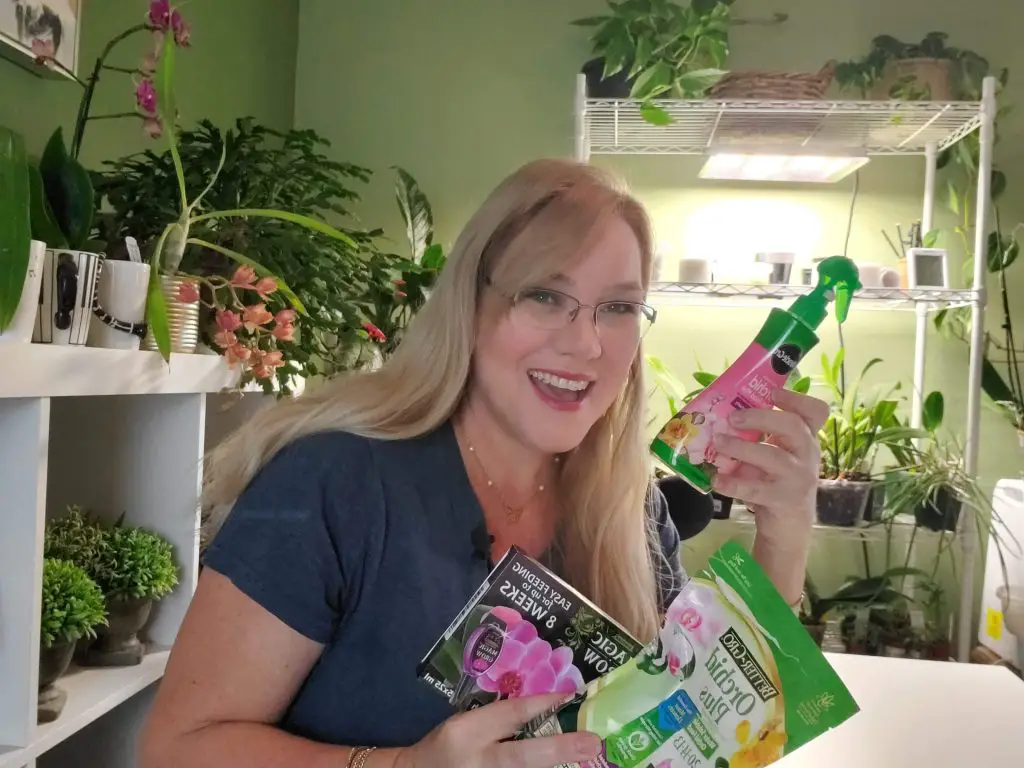
Reminder: don’t use orchid fertilizer when the plant is dormant.
It will be practically useless. There won’t be any harm done if you do, but you’ll be watering your money down the drain.Research to better understand your orchid’s life cycle to know when to use orchid fertilizer.
Some orchids will bloom during summer, others during winter. Summer bloomers will prefer more fertilizer during their winter months than a winter bloomer will. Other lucky species bloom twice a year, so you’ll need to keep fertilization constant.
If you want a graph of when you fertilize, the American Orchid Society  made a good chart that is fairly easy to follow and use. Also, if you want a similar but more complete guide about fertilization in PDF form, sign up for our newsletter and it will be sent to your email. You’ll be able to print it off and keep it handy.
made a good chart that is fairly easy to follow and use. Also, if you want a similar but more complete guide about fertilization in PDF form, sign up for our newsletter and it will be sent to your email. You’ll be able to print it off and keep it handy.
After the flowers fall off and the flower spike drops, most orchids will go into a dormant period. If you decide to cut the spike leaving two or three nodes to induce rebloom, then continue the fertilization, since this will stimulate it tokeep producing new growth.
If not, when you cut back the flower spike to the nearest node next to the base, growth will halt and the orchid will go dormant. These next few weeks up to a few months you can use less fertilizer.
The Best Orchid Fertilizer Methods on the Market
If you do a quick research on Amazon or eBay, you’ll see literally thousands of options for orchid fertilizers, ranging anywhere from 3 to 60 dollars. They may be liquids, to which you need to dilute in water. Some can come as misting sprays; others are self-dissolving crystals.
To pick the one that is the right fertilizer for you, you’ll need to incorporate fertilization into your weekly routine. It doesn’t matter if the fertilizer is a top-notch brand if you simply forget to use it.
Find a method that will easily integrate into your watering cycle, so you can do both activities at the same time.
I’ll discuss 5 distinct and unique methods below.
This video is specifically about the 5 methods I talk about below.
Orchid Fertilization Methods
Instead of rating extremely different fertilizer brands that have no common denominator between them, I’ve decided to do a review of the different methods of orchid fertilization that were available.
For the first three reviews, I stuck to one name brand, Miracle-Gro, not because I have any monetary affiliation with them—I don’t—but because I believed the variables would be more easily controlled for a review.
Besides, the name brand, Miracle-Gro, holds credibility on the market, that is why I picked it.
In essence, it would the same fertilizer, but different methods of using it (or so I thought…) Miracle-Gro has three forms of feeding: water-soluble, mist, and spikes, which cover the three of the five methods.
The other products are not Miracle-Gro, because I wanted to present the different methods of orchid fertilization on the market.
1: Water Soluble Fertilizer for Orchids
My first review is for the water-soluble fertilizer method. It’s very easy to use, since you mix a small amount (¼ of a teaspoon) into one gallon of water. When you water your orchids, you’ll water them as normal, but then water them again, using the “fertilized water.”
I have taken Miracle-Gro Water Soluble Orchid Food (Affiliate Link) as my example. It comes with a 30-10-10 concentration in 8 oz bottles.
as my example. It comes with a 30-10-10 concentration in 8 oz bottles.
The instructions say to use this every other week on any acid-loving plant, not only orchids. Since orchids love a pH of around 5.5 to 6.5, this works well.
During the rest or dormant periods, the producers recommend fertilizing only once a month. They also recommend not pouring the fertilizer on the leaves, which wouldn’t be what we’d do to orchids, anyway.
Of the five products, this one has the highest concentration of all three N, P, and K. This might be a signal to new orchid growers to test the other products first, and gradually you’re your way up to this one. If done wrong, it could cause extreme root burn.
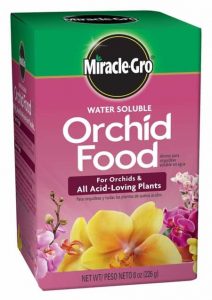
Pros
This product is relatively inexpensive and will last you an eternity if you only have one orchid. It’s also very easy to use and comes with great directions. The value for your money is more than exceptional, which is what we’re aiming for.
Cons
The impractical side of this fertilizer is that if you only have one orchid, what will you do with a gallon of water left over? With one gallon of water, you can fertilize up to 30 or 40 orchids. To have this much water sitting aside just to be thrown away afterward is a shame.
In defense of Miracle-Gro, they did answer this concern. You can store the gallon of water in a shady area up to two weeks. That still means using half a gallon of water for one orchid.

Also, the photo on the product wrongly influences you to use exaggerated amounts.
It shows a lady using a teapot, which probably holds 16 to 18 ounces of water. A gallon has 128 ounces. Big difference…As for the consumers’ opinions, the overall rating was good. In a few of the comments, people reportedly said their orchid died after two weeks of using the fertilizer, shriveling up. This is a definite sign of root burn, probably from using a concentration higher than the recommended dose.
As in any water-soluble method, this can be a real concern.
The biggest con in this product is the misinformation about its Nitrogen component. As mentioned earlier, orchids get some of their macro and micronutrients from the air. Nitrogen is one of them.
This product in the water-soluble formula does not use Nitrogen in a form that is beneficial to orchids, but uses 27% urea nitrogen. This concentration is extremely high when we’re trying to avoid urea at all costs.
The excessive build-up of ammonia, which is nothing less than a component of urea. One consumer mentioned that her plants smelled like ammonia, and ALL her orchids died of root rot after one year of applying Miracle-Gro.
The company did not respond to this observation/complaint.
No response? Really?
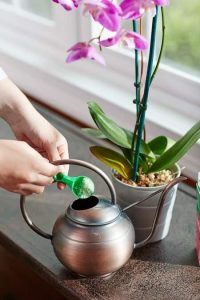
To be honest, I can’t judge if that is the person’s fault for overwatering, or not letting the orchid dry out, or poor potting medium, but to blame it strictly on the fertilizer seems a bit lopsided. If the commentator had 15+ years of orchid experience I’d be more complacent. This was not the case.
With a 68% of 5 stars and 14% of 4 stars, this still was a very highly rated product at:
82% highly satisfied customers.
Where to Buy Water-Soluble Fertilizer
You can go to their site and read more about their product, or buy it directly on Amazon (Affiliate Link). I found it to be slightly more expensive directly on the Miracle-Gro page than found at various sellers on Amazon.
I found it to be slightly more expensive directly on the Miracle-Gro page than found at various sellers on Amazon.
2: Misting Method for Fertilizing Orchids
The second method on my list is from the same company but in a mist form. In this method, you will water the orchids as normal. In addition, you’ll use a misting spray on the leaves and roots of your orchid.
The number of times to be misted varies from daily to once a week.
Misting sprays have a smaller concentration of N-P-K since you will be using it more often and directly on the leaves and roots. There is no need to dilute it, since it already comes watered down (too watery, in my opinion.)
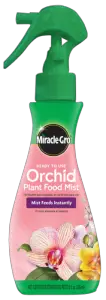
I have chosen  Miracle-Gro® Ready-To-Use Orchid Plant Food Mist
Miracle-Gro® Ready-To-Use Orchid Plant Food Mist as my example to review.
as my example to review.
On the instructions of this mist, it says to spray the orchids once a week directly on leaves, roots and soil. The only place to avoid the misting is on the blooms.
72% of consumers gave this fertilizer 5 stars, and 12% gave it 4 stars, totaling 87% in the highly-satisfied category.
There were only four negative reviews.
What is a bit funny though, pardon my sense of humor, was that one of the negative reviews was not being able to make the spray bottle work. After much frustration, the irritated customer tossed the entire bottle.
With respect to the company, they did write back, maintaining good customer service and explained where the switch is.
To allow the spray bottle to mist, there is a button which is the exact same color as the misting device that needs to be turned. Maybe it’s just me, but I think this is a poorly manufactured product when it comes to design… But that really has nothing to do with orchid growth.
The other four negative reviews said that the orchid shriveled up and died, after the leaves fell off. Again, this can be due to a variety of factors.
The concentration of the fertilizer, 0.2-0.2-0.2 It’s not likely that the fertilizer had anything to do with the shriveling up of their leaves. In fact, I wrote an article about why orchid blossoms wilt, which you can read here, and none of the reasons are this specific fertilizer.
In fact, is that even a concentration at all? Am I just spraying 5 dollars of pure water on my orchid? As for me, if I were going to invest in a fertilizer, then I’d want one that actually had fertilizer in it.
Pros
This is by far the easiest method yet if you are a beginner. The directions are very clear and user-friendly. Honestly, there’s no added steps here—open and mist. Straight forward, if you can get the bottle to open.
The product is odorless, which is understandable with such weak concentration. You’re practically smelling water.
The good thing is that if you are a new orchid grower, you practically can’t go wrong with this fertilizer. Its weak concentration won’t allow it. This would be a good product to ease into other fertilizers, once you get the hang of orchid fertilization.
It might be more time-consuming than the first, since spritzing each, single orchid several times every single week is going to build up the muscles in my hand, but still…
Several consumers took the work to write a positive and encouraging review, which in our opinion, always enhances the product. Most said their orchids perked up, became vibrant green, and “came to life” after a few weeks of misting.
Another positive side was that the majority of the comments came from experienced orchid growers, and not beginners.
This speaks volumes.
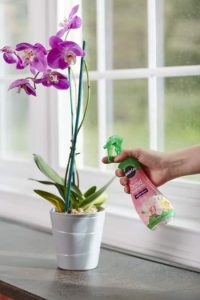
Cons
Expensive for the money.
If compared to the first example, in a diluted water system, you can expand your money into a year-long supply of fertilizer.
Not so with the mist.
The mist is so thinly diluted that it hardly has an effect at all, and only lasts 3 to 4 months if you have one orchid.
Where to buy
You can check out the product page at Miracle-Gro , which was more expensive than several sellers at Amazon (Affiliate Link).
, which was more expensive than several sellers at Amazon (Affiliate Link).
The initial price is cheaper at Miracle Gro, but at Amazon, you get 2 packs for the listed price of just one.
You can also get 6 packs, lowering the price considerably. All of these are cheaper than the one listed on the Miracle Gro page.
3: Plant Spikes Method as an Orchid Fertilizer
The third application is in sticks that you place directly in the potting medium. In addition to being complete fertilizers, (having all three N-P and K) they are also balanced (in the same proportion 10-10-10.)
To know how many sticks you use, you have to verify the pot measurements and the room from the stem to the outer rim. The directions instruct you to break the stick in half and use half a stick on each side of the orchid.
We have chosen Miracle-Gro® Orchid Plant Food Spikes to use as our example.
The instructions say to use the sticks when the orchid is in its active growth stage (and they include the blooming in this, which I don’t think is technically correct.) But they definitely recommend using the fertilizer stick when you notice a new flower spike or roots.

The instructions also say that during the winter months, from October to February, you’ll need to use less fertilizer. It does make us question the winter-blooming orchids—or does this fertilizer not distinguish between those species?
The dose expires every two months, so each packet (which contains 10 spikes) can last almost two years for each orchid.
As for the comments: 91% of the consumers had positive comments, including 5- and 4-star ratings. Only one consumer had a negative review (1 star), and it was over 4 years ago.
By far, the percentage of approval is higher than the first two orchid fertilizers. The negative review was just that the orchid died. There could be so many reasons for this, and the comment was a bit vague.
Pros
The instructions in this fertilizer are complete and extremely user-friendly. Thumbs up! They go into more detail about other issues like lighting and have a time-table of how to effectively use the fertilizing sticks.
The product is made to use and forget about it. No constant and daily spritzes, no manual watering—nothing. This is the most time-efficient method if you are busy and tend to forget to fertilize your orchids.
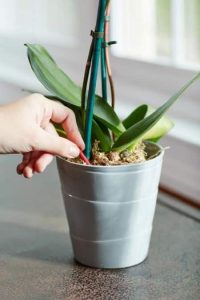
Due to its 10-10-10 concentration, which is a medium-range in between the mist and the water solute, it’s a good intermediate level orchid fertilizer.
There is also the detail about humidity:
with all the misting, you are killing two birds with one stone.The majority of the positive comments were about the new roots and flower spikes, but we have yet to find a consumer claiming that the orchid’s flowers were healthier, more vibrant or anything of the sort.
This is probably due to the lower Nitrogen (10 as compared to 30 in the water solution) but this is only my hypothesis.
Cons
The stick remains in the potting medium dissolving a little bit every time you water the orchid. This can cause issues if the package has fungus or other bacteria on them when inserted into the potting medium.
Also, there is no way to effectively rinse out the fertilizer to avoid salt build-up and residue, since every time you water, you release more fertilizer.
The orchid that best responded to this fertilizer was the Phalaenopsis, as one consumer stated, but the other orchids (Cattleyas, Dendrobiums, Oncidiums, and others) reacted badly to the spikes.
Where to Buy
During the period that this research was conducted, both Miracle-Gro internet page , and the product on Amazon (Affiliate Link)
, and the product on Amazon (Affiliate Link) were exactly the same price, down to the same cents.
were exactly the same price, down to the same cents.
Since we do get a small cup of coffee for each Affiliate Link with no extra cost to you, may we highly recommend you check out the Amazon one? We sure do appreciate it! 🙂
Don’t Stop Learning!
If you want to be included in more information and get a 14-page fertilization guide, please sign up for my newsletter. I don’t spam, but send emails out bi-monthly with some curious topics of interest. If you want more information, click here to go to a specific page on this website where I explain it more in detail.

Also, if you are looking for an orchid journal to keep your notes specifically about orchid care, check out my 2 solutions for that on this page. If note-keeping isn’t your thing, then there is a free excel spreadsheet that you can download. Click here for more information on how to do that.
If you subscribe to my newsletter, I will send you a 14-page guide on the main tips of orchid fertilizer. It is downloadable and you can print it out on your computer. I designed the guide to double up as a coloring book, just to make it fun.
4: Slow Release (6 Month) Orchid Fertilizer in Pellets or Granules
The fourth method of fertilization is using slow-release pellets. You sprinkle a handful of pellets on the top of your porting mix and leave them there for 6 months.
I’ve chosen SMEREKA Orchid Food Fertilizer Slow Release (6 Month) Fertilizer (Affiliate Link) as my example to illustrate this method.Maybe it’s just me, but look at that green contrast in the dark brown potting mix!
as my example to illustrate this method.Maybe it’s just me, but look at that green contrast in the dark brown potting mix!
Isn’t it gorgeous?
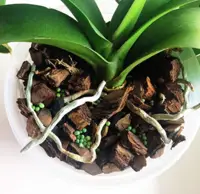
Ok, I know… this isn’t an item that makes that much difference in the health of the orchid, but, dang…
It’s a beautiful sight for the potting medium.
Every time you water the orchid, the pellets will release a little of the fertilizer. This is for sure a hands-off approach to fertilizing.
Pros
A method you can literally forget about for half the year. Add a handful of pellets or granules to the moss and reduce your workload by a lot.
This lesser-known brand claims to help the flowering, but the levels of nitrogen are higher than both phosphorus and potassium (14 compared to 10 and 10).
Interestingly enough, they stay true to their advertisement.
All the comments were about how much better the flowers had bloomed, how much longer they stayed in bloom, and how orchids which had never bloomed before were now blooming.
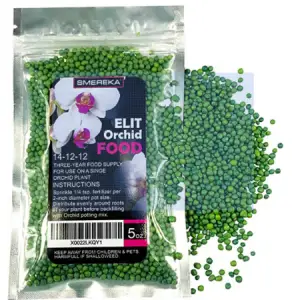
Moneywise, this option is the best due to the fact one bag will last you for three years.
The resealable bag is great for not drying out the fertilizer or exposing it to air.
Your initial investment might be a little more (a couple dollars) but the final total over three years is a lot better.As for the consumers, 83% gave this method five stars.
Only 17% gave it three stars. I read every single one of the reviews – they only gave it three stars because they hadn’t had time to adequately evaluate the fertilizer. It sounded more like a neutral evaluation.
And no one—not a single soul—gave this item a two or one star.
You can’t beat that for happy orchid enthusiasts.
Cons
As for the cons, there wasn’t much to add to this section.
One concern though, was that the pellets stay continually in contact with the potting mix. It’s harder to rinse out thorough, since the more water you apply to the orchid, the more it releases fertilizer.
In time, this could raise the levels of toxicity and encourage medium breakdown faster.
Where to Buy
At the time of this article, I did not find the SMEREKA brand outside what was listed on Amazon. I’m just not sure if they don’t have a website or if they just sell to larger growers. If you do know how to get in contact with the company, please comment below.
You can find them here (Affiliate Link).
5: Slow Release Liquid Orchid Fertilizer
In the last method of orchid fertilization, and less popular too, is the water-drip method. It’s literally a hands-off method that works by itself.
You insert a small packet or pouch of liquid fertilizer that slowly and constantly drips over a two-month period.
We have chosen
SMEREKA Orchid Food Fertilizer – Liquid Drip Orchid Feeders 5x25ml Pack – Easy Feeding for Plants (Affiliate Link)
as our example.

Pros
If you constantly go on vacation, this might be a good method to use. Insert the packet into the potting medium and off you go to have fun.
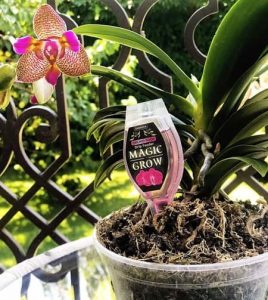
Cons
What is in these packets?
There is absolutely no information about the N-P-K whatsoever.
As far as we know, we might be feeding my orchid pink water. A serious seller would have the N-P-K ratio on the package, or at least answer the questions about N-P-K when asked…
(but that’s our opinion.)In the instructions, you snip the top off the packet, turn it upside down and insert it into the pot. It can last up to two months. But what if it runs out in two days? Well, the company did address this, and said that could be normal.
Wait, what???
This can’t be good for your orchid. A two months supply of fertilizer in two days? With no drip-control, there isn’t much to say as to how much fertilizer is being constantly dripped into your potting mix.
Another con is the price. One package contains five packets. Each packet lasts up to two months (or two days…). Compared to the other methods, this one is a little more costly.
As for the consumer reviews, this method took a definite hit.
More than half the reviews had negative feedback, with a whopping 44%. The complaint was the same: it dripped out in twelve hours or less.
The cause of such a high concentration of fertilizer over such a short period of time will be root burn, and this was a common topic in the discussion. Many consumers had their orchids die after using this drip method.
Where to Buy
Hmm, seriously? I’ve added the link here (Affiliate Link) but this is my least preferred method.
but this is my least preferred method.
Once again, I couldn’t find a website or customer service phone number to reach the company, so Amazon it is…but please don’t… Just don’t.
Now that you know all about fertilizing your orchid and the 5 different methods, it’s time to get your hands dirty and build an orchid floral design. Check out some of our tutorials on how to do that or how build a terrarium with orchids.
Not your thing? How about reading some more? Check out our articles about potting medium,using charcoal, or watering while on vacation.
If you are curious about other methods of fertilization that do not involve store boought products, check out these articles I wrote about:
How to Fertilize Orchids In Water Culture
3 Ways To Fertilize Orchids in Sphagnum Moss
3 Proven Methods for Using Tea bags as Orchid Fertilizers
Using Leftover Orchid Fertilizer on Household Plants
Are Eggshells Good Fertilizers for Orchids?
Fertilizer Supplements: Is Epsom Salt Good for Orchids?
Update: Due to thousands of spam a day on this specific article, I’m closing down comments on this specific page. 🙁 I sure hope they don’t do this do my other articles…
If you really want to more info or have a question, please go to the contact page or the about page- both can get a message to me. If this information was of any help or clarified any doubts you had, please mention so in your email. Also, if you do happen to know what the N-P-K ratio is in the drip method, please tell me.
I love to interact with other orchid enthusiasts, but I have no patience for spamming. We all can share from our experiences. Share this page with a friend who has an orchid, comment, or give me a thumbs up 😊 in the comments on another page.
Happy cultivating!


Hello, I enjoy reading all of your article.
I wanted to write a little comment to support
you.
Hi Isabel! Thank you so much! I really put a lot of effort into the posts and when I get a comment like yours, it really makes my day! 🙂 🙂 🙂
Very helpful to me, just awesome thanks
Thank you, Sandip! I appreciate your words! 🙂